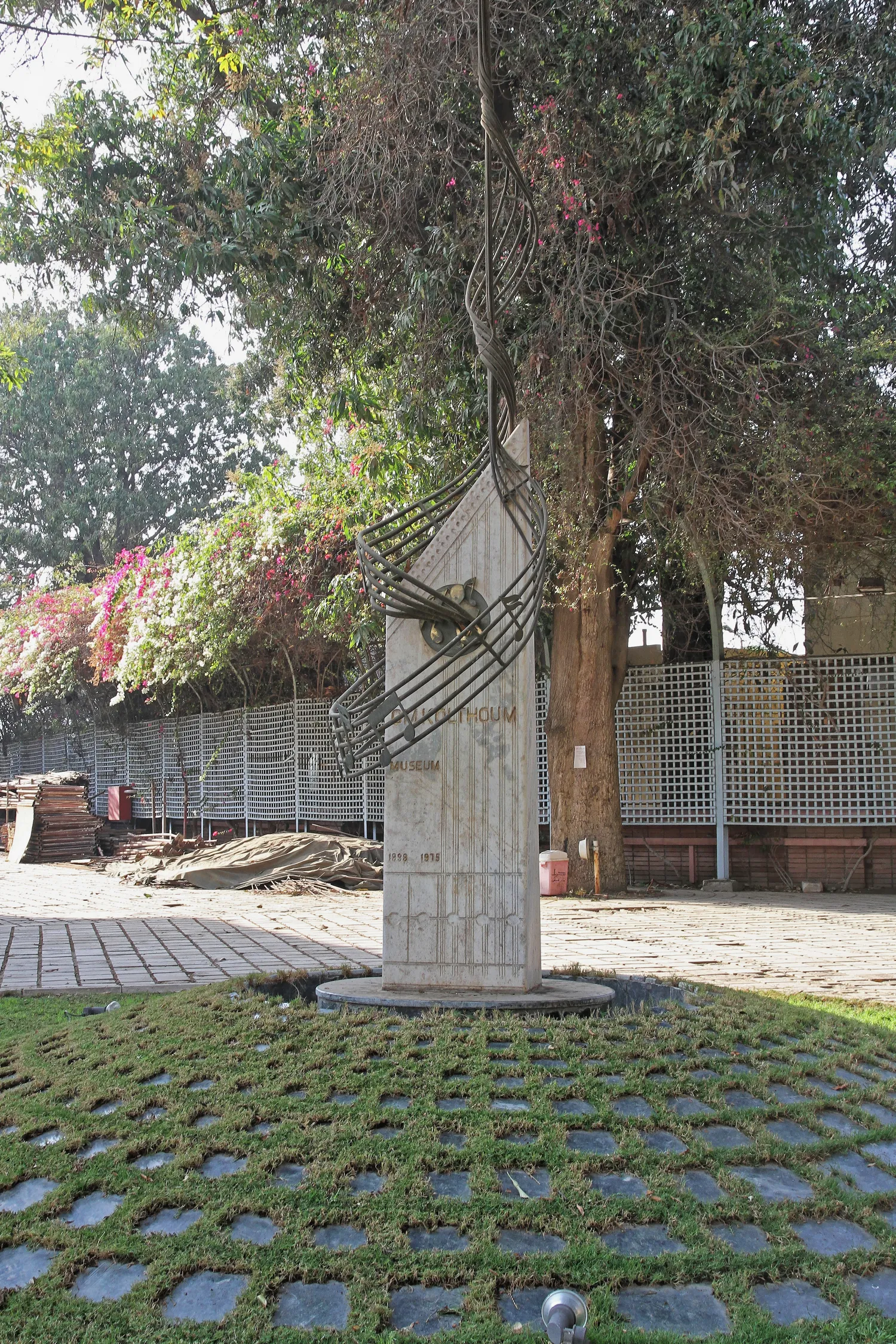Umm Kulthum’s Museum: A Visit to the Glorified Past

Updated On: April 15, 2024 by Ciaran Connolly
Like Sir Elton John is to Britain, Elvis Presley is to America, and so Umm Kulthum is to Egypt and the Arab world. The name stands by itself as the face of music, culture, and an era – Umm Kulthum reflected all that through her voice.
But Umm Kulthum’s fame was not only restricted to the Arab region; her rich contralto voice could also be heard in Europe, which also sang the praises of “the lady” (El Sett in Arabic), who came to be known as “The Voice of Egypt”, “Star of the East”, and “Egypt’s Fourth Pyramid”.
Being so important to Egypt, the Culture Ministry decided to establish a museum to niche all her personal belongings. Umm Kulthum’s Museum is meant to preserve the legacy of one of Egypt’s icons and to keep her songs playing in the listeners’ heads. It is more or less a biographical museum commemorating one of the top 10 most famous singers in Egypt.
The story of Umm Kulthum
The story of Umm Kulthum is one about a rise from zero to hero. She began in the village and ended up in the city, and throughout this journey, many stops could be called milestones that helped her make further steps forward.
Her early Childhood
Born Fatima Ibrahim el-Sayyed el-Beltagi on 31 December 1898 to a father who was an imam and only sang religious chants in a village in the Nile Delta city of Daqahilya, Umm Kulthum learned to recite the holy Quran at a young age. Still, in Tamay el-Zahayra village and dressed up as a boy, Umm Kulthum sang with her father at weddings to be able to provide for her family.
Her beginning
At the age of 24, Umm Kulthum moved to Cairo, where she met her mentor Sheikh Abul Ella Mohamed, and three years later, in 1926, she signed her first recording contract. Her voice mesmerized all segments of Egyptian society and was recognized as the best by people, poets, and even her colleagues.
Her overseas tours
With both her feet now on the ground, Umm Kulthum made her first tour outside Egypt in 1932, performing in Syria, Iraq, Lebanon, Tunisia, and Libya. She thrilled the audience with her long songs that could last for over an hour.
In 1934, she was part of the inaugural broadcast of Radio Cairo, and from then onwards, she had a concert on the first Thursday of every month for forty years. Fans of Umm Kulthum would rush back home to tune in to her monthly concerts, which usually cleared the streets of some of the most populous Arab cities. During those concerts, Umm Kulthum would generally perform three extended songs that could last up to five hours of “tarab” – a state of rapturous enchantment by the music.
Umm Kulthum made her only performance in Europe in 1967. She sang at L’Olympia in Paris and was quoted as saying: “No one can describe the extent of my pride when I went to Paris, stood in the middle of Europe, and raised my voice in the name of Egypt.” Umm Kulthum has deservedly been named among Rolling Stone’s “200 Greatest Singers of All Time”.
Her political impact
Gaining acclaim in then the Kingdom of Egypt, Umm Kulthum was honoured by King Farouk I, who bestowed the “Nishan el Kamal” – an order reserved for the Royal Family members – on her in 1944.
When the Republic of Egypt was established in 1952, Umm Kulthum also developed a close friendship with then-president Gamal Abdel Nasser. Many of her songs were particularly orchestrated to support Nasser, and one of those was adopted as the national anthem of Egypt from 1960 until 1979.
Umm Kulthum received a diplomatic passport in 1968, and she was the first woman to be given the title of Egypt’s First Lady.
Her death
On 3 February 1975, Umm Kulthum breathed her last at the age of 76. It was a great tragedy for Egypt, and it made news headlines both at home and abroad. Her death was reported by “Times” magazine and Germany’s “Süddeutsche Zeitung” magazine.
About Umm Kulthum’s Museum
This museum is an incarnation of all that is termed nostalgia. Grouping all the items that could recapture moments from the past, the museum of Umm Kulthum takes visitors on a backward journey to the history of music in a country that is the cradle of Arab culture.
The idea to have the priceless belongings of this reverent singer grouped for display in one place started in the late 90s. In 1998, the Ministry of Culture began to collect all that could be Umm Kulthumian, starting from her clothes and accessories to musical works and awards she got throughout her singing career.
Where & When
There, at the Monastery Palace in the Manial district of Cairo, over an area of 250 square metres, an adapted section of the palace has been dedicated to Umm Kulthum’s Museum. Small as it is, the L-shaped museum is divided into four sections that tell the story of this legendary and internationally acclaimed singer.
The museum was opened to the public in 2001 to honour the memory of Umm Kulthum. Its colour scheme is grey, black, and silver, and the showcases are made of dark Bali-Sander wood.
The Main Hall
Visiting Umm Kulthum’s Museum, fans of the legendary singer will be able to get a glimpse of her make-up through a collection of her belongings on display inside eight windows at the Main Hall.
Eight dresses in good condition are niched in one of the sections with a long list to show which dress she wore and in which concert, movie, or party. Umm, Kulthum would always appear in bejewelled floor-length gowns that reflected her regal stage presence and conservative background. The silk scarf that Umm Kulthum held in her left hand during performances is also displayed.
Also shown are Umm Kulthum’s famous jewel-encrusted cat-eye sunglasses that she used to wear to protect her eyes against prolonged exposure to stage and studio lighting.
The microphone that Umm Kulthum used for her first radio performance is also there. The museum also houses some rare musical instruments that belonged to Umm Kulthum’s band. The visitors will also see five murals of rare pictures of “the lady” – El Sett in Arabic – as she was called.
Medals, including the one presented by King Farouk I, and decorations that Umm Kulthum received from governments are placed here. The visitors can also see the original copies of some musical notes and poems that later turned into songs of Umm Kulthum at this Main Hall.
Also, letters exchanged between the singer and Arab leaders and public figures, as well as private papers and notes, can be seen in the museum’s Main Hall. These include thank-you letters to Umm Kulthum for her support for the Egyptian army through her fundraising concerts in some Arab countries. The visitors can also read pages of her restored diary that were moved to the museum.
The Cinema Hall
With songs of Umm Kulthum played in the background, visitors will tour the different parts of the museum until they reach the Cinema Hall – where a 26-minute documentary about Umm Kulthum is being played.
The documentary is produced by the Cultural Development Fund and is shown with English and French subtitles. It depicts her life story, including her family and school.
Scenes from her six movies and parts of her concerts are also shown in the documentary, which ends with excerpts from the funeral of Umm Kulthum. It is a memorabilia of her performing and recording career.
The Audio-Visual Library Hall
Entering the Audio-Visual Library Hall, visitors will see five computers on which all the songs and concerts of Umm Kulthum are downloaded. The Visitors can also browse through pictures of her concerts and trips in Egypt and to several countries.
The library has a complete record of newspaper clippings about Umm Kulthum covering the period from 1924 until 2000, as well as a digital photo gallery.
The Panorama Hall
Visitors will also go through a passageway with a screen that serves as a moving panorama. This is the Panorama Hall, where they will see pictures of Umm Kulthum at different ages. Some photos of “the lady” with some renowned artists and singers are also available in this section. The visitors will enjoy going through the pictures to the tunes of the music of the famous composer Rageh Daoud. This part is set to last for 10 minutes.
A 15-minute silent documentary about Umm Kulthum is also shown on a cinematic screen, and it sheds light on all of her concerts in Egypt and abroad.
Recalling the Glory of the Past
This is not just a physical visit to a museum.; when visitors come to Umm Kulthum’s, they travel back in time to where everything had great value. Everything about Umm Kulthum was a trademark, and her legacy is commemorated in this museum which bears her name.
Forty-eight years after her death, Umm Kulthum is still number one in Egypt and the Arab world. There is no artist as respected as she was and still is. Umm Kulthum’s voice and music are also appreciated by some of the West’s greatest singers, including Bob Dylan and Maria Callas. Umm Kulthum truly exists out of time!






